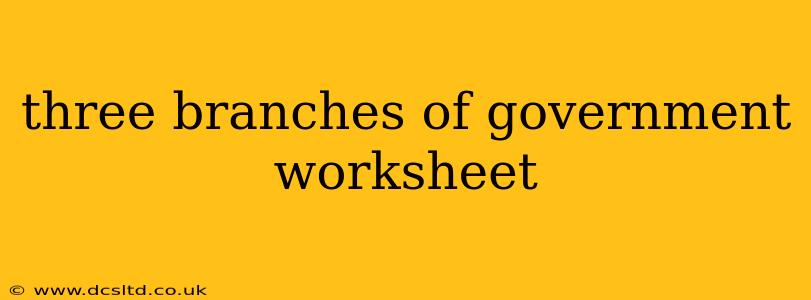Understanding the Three Branches of Government: A Worksheet
This worksheet will help you understand the three branches of government in the United States: the Legislative, Executive, and Judicial branches. We'll explore their roles, responsibilities, and how they interact to maintain a balance of power.
Part 1: Matching
Match the branch of government with its primary function:
| Branch of Government | Primary Function |
|---|---|
| 1. Legislative | a. Enforces laws and commands the military |
| 2. Executive | b. Interprets laws and settles legal disputes |
| 3. Judicial | c. Makes laws |
Answers: 1-c, 2-a, 3-b
Part 2: Fill in the Blanks
Complete the following sentences describing the key responsibilities of each branch:
-
The Legislative branch, composed of the Senate and the House of Representatives, is responsible for _____________ laws.
-
The Executive branch, headed by the President, is responsible for _____________ laws and carrying out the government's policies.
-
The Judicial branch, headed by the Supreme Court, is responsible for _____________ laws and resolving legal conflicts.
Answers:
-
The Legislative branch, composed of the Senate and the House of Representatives, is responsible for creating/making/passing laws.
-
The Executive branch, headed by the President, is responsible for enforcing laws and carrying out the government's policies.
-
The Judicial branch, headed by the Supreme Court, is responsible for interpreting laws and resolving legal conflicts.
Part 3: Checks and Balances
The U.S. government employs a system of checks and balances to prevent any one branch from becoming too powerful. Describe one check each branch has on the other two:
-
Legislative Branch Check on Executive Branch:
-
Legislative Branch Check on Judicial Branch:
-
Executive Branch Check on Legislative Branch:
-
Executive Branch Check on Judicial Branch:
-
Judicial Branch Check on Legislative Branch:
-
Judicial Branch Check on Executive Branch:
Possible Answers (There are others):
- Legislative Branch Check on Executive Branch: Can override a presidential veto; can impeach and remove the president.
- Legislative Branch Check on Judicial Branch: Can impeach and remove federal judges; can propose constitutional amendments to overturn judicial rulings.
- Executive Branch Check on Legislative Branch: Can veto legislation passed by Congress.
- Executive Branch Check on Judicial Branch: Appoints federal judges.
- Judicial Branch Check on Legislative Branch: Can declare laws unconstitutional.
- Judicial Branch Check on Executive Branch: Can declare executive actions unconstitutional.
Part 4: Thinking Critically
Why is the system of checks and balances crucial for a democratic government? Explain your answer in a short paragraph.
Possible Answer: The system of checks and balances is crucial for a democratic government because it prevents tyranny and protects individual rights. By dividing power among three branches and giving each branch the ability to limit the power of the others, it ensures that no single branch becomes too dominant. This fosters fairness, accountability, and prevents abuse of power, ultimately upholding the principles of democracy.
This worksheet provides a foundation for understanding the three branches of the U.S. government. Further research and exploration will deepen your knowledge of this crucial topic.
